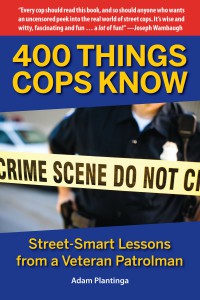Today, we welcome Adam Plantinga to the blog to share a few tips about the reality of police work. A sergeant with the San Francisco Police Department, Adam is the author of 400 Things Cops Know: Street-Smart Lessons from a Veteran Patrolman, published today by Quill Driver Books. He’ll make you laugh, but he’ll also make you smarter. Read on.
 Playwright Arthur Miller once said drama is a compressing of time. You need to make a lot of things happen in a short span. That’s why you skip the slow stuff to keep the audience engaged. So if cop shows, books, and movies aren’t very realistic, it’s okay, because that’s just how narrative best functions. But you still want to craft a work that rings true when it counts. It’s a bit of a balancing act. To aid in this endeavor, I have listed examples below to keep in mind if you are writing a police-related novel or screenplay and wish to sound reasonably authentic.
Playwright Arthur Miller once said drama is a compressing of time. You need to make a lot of things happen in a short span. That’s why you skip the slow stuff to keep the audience engaged. So if cop shows, books, and movies aren’t very realistic, it’s okay, because that’s just how narrative best functions. But you still want to craft a work that rings true when it counts. It’s a bit of a balancing act. To aid in this endeavor, I have listed examples below to keep in mind if you are writing a police-related novel or screenplay and wish to sound reasonably authentic.
1. Fiction: Even the most willowy of cops kicks down the suspect’s door in a single blow.
Reality: Doors, especially exterior ones, can be onerous to take down. Once it took me twenty-seven tries. I know this because there was a sergeant next to me counting out loud encouragingly. And the most effective means of entry isn’t the manly snap kick where you face the door with your shoulders squared, but rather the ungainly mule kick, where your back is to the door and you lash out with your foot like Eeyore.
2. Fiction: The male cops are ruggedly handsome and frequently shirtless, with toned, tan physiques. The female officers have shimmering hair with a lot of bounce to it and commendable skin.
Reality: We are not as gorgeous or dynamic as our fictional counterparts. Some cops look like they’ve been hit in the face with a crowbar. (Some, have, in fact, been hit in the face with a crowbar. It’s that kind of job.) If cops looked like models, believe me, we’d be models. That gig would beat sprinting down some dirty alley after a knife-wielding meth addict any day.
3. Fiction: Local law enforcement has just started investigating the big case when the feds swoop in with their trench coats and sunglasses. One of the feds says, “We’re taking over.” A bitter argument about jurisdiction ensues.
Reality: If the feds show, you probably have a massive migraine of a crime scene on your hands that involves something you don’t deal with much (a train derailment, a nasty hazardous materials situation, a multi-state crime spree). So if some three letter agency offers to be on point, your reaction is likely going to be Thank the Lord. The FBI really wants this mess? It’s all theirs. Maybe you can still make your daughter’s piano recital after all.
4. Fiction: The hero cop shoots a few bank robbers in the afternoon, and returns to work the next morning full duty as some police colleague comments, “Nice work yesterday.”
Reality: If you are in an officer-involved shooting, you are immediately placed on administrative duty pending the completion of the investigation. There’s also mandatory counseling involved. Police shootings are relatively rare and a very big deal. They are treated as such.
5. Fiction: Plainclothes cops or detectives in suits walk around in public with their guns out but no visible form of police identification.
Reality: You are required to have your badge/ID out if your firearm is showing. How are civilians supposed to know you’re a cop as opposed to just some nutjob walking around with a firearm? Even other police officers may not know who you are, especially on larger departments. Is everyone just supposed to intuit you’re the police because you have that shimmering hair with a lot of bounce to it?
6. Fiction: The two detectives interrogate the suspect and cut right to the chase. After a few minutes, the suspect breaks down and gives a full confession.
Reality: Interrogations start with rapport-building. You want to find out something about the suspect first. Where he grew up, which school he went to, if he has siblings. You usually don’t even touch on the crime at hand until you’ve gotten him comfortable talking to you. Then there’s bathroom breaks. Maybe even a proffered fast food meal. The whole process can take hours. Usually the only people who confess within a few minutes are juveniles.
7. Fiction: The police protagonist knowingly enters an incredibly dangerous situation alone, often muttering, “There’s no time for backup.” He also is equipped with a flashlight that only seems capable of illuminating the first three feet in front of him.
Reality: There’s almost always time for backup. If there’s one suspect, at least two to three cops will respond. Two suspects? No fewer than four. Three or more bad guys? The whole shift is showing up. Police aren’t superheroes. You succeed because you use training, tactics, and superior numbers.
Also, our flashlights work just fine.
 Adam Plantinga is a sergeant on the San Francisco Police Department and the author of the just-released book 400 Things Cops Know: Street-Smart Lessons from a Veteran Patrolman, available from Amazon, Barnes and Noble, local booksellers, and from the publisher, Quill Driver Books.
Adam Plantinga is a sergeant on the San Francisco Police Department and the author of the just-released book 400 Things Cops Know: Street-Smart Lessons from a Veteran Patrolman, available from Amazon, Barnes and Noble, local booksellers, and from the publisher, Quill Driver Books.
